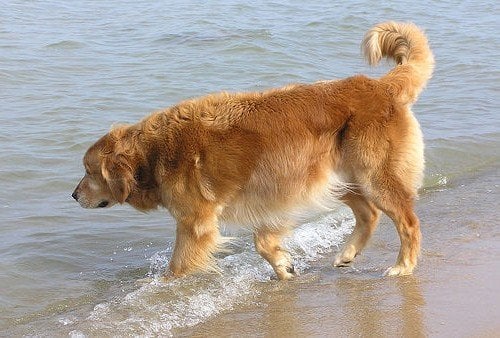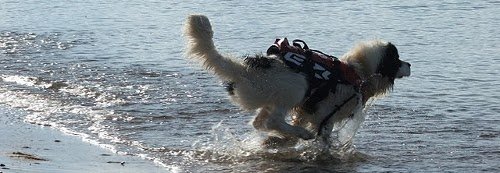
Many dogs love swimming, especially if they can do it together with their owners. However, quite typical is the story where you go to a lake (or wherever you swim) only to discover that your dog is afraid of the water. In this article, you are going to learn how to get your dog to swim.
Should you accept that your dog won’t be a diving champion, or should you try to foster his interest in swimming?
It’s not a simple question to answer on a website, as every case must be examined separately. If your dog is often afraid, think twice about whether you need to expose him to the stress of swimming. Maybe it’s not worth it. Do you have a good enough reason for wanting your dog to swim that outweighs the effort? Only you can answer this question.
Don’t force your dog into the water
If you decide that you should give it a try, the number one rule to remember is: “Don’t force him!” Throwing a dog into the water won’t help his fear, no matter what some may tell you. It’ll just make the fear even greater, and your dog might never accept swimming as a pleasant activity.
- Go to a place with shallow water. This will make it possible to play in water without the hardest part: swimming.
- Observe how close to the water your dog is willing to go. No matter whether he likes to get his feet wet or he feels safe only on the shore, you must note where his border is (the line he is not willing to cross). And, most important, you should respect that border for now.
- If your dog feels comfortable on the shore, start playing there. Use toys, treats, praise. Run with him without crossing his border, or perform some training commands. Have fun!
- After a while, you might try to go near the water or even enter it. Do so seamlessly, without drawing too much of your dog’s attention. Continue playing as before and just move toward the water. If your dog seems uncomfortable, move back to his safe zone.
- Encourage your dog. Show him a treat or throw a toy. Splash the water with your hand to create interest. If your dog is still resistant, step aside. It’s not the right time yet, and you need to play more at a safe distance. For how long? It depends on the dog. A short break might be enough, or you might need to take a day off. Remember that training sessions that are short, fully focused, and filled with positive experience always work the best.
- If your dog comes near the water or enters it, praise him. Give a treat, play, and keep having fun. But carefully observe his behavior. Don’t restrain him if he wants to go back. Once he is back in his safe zone, praise him and show how proud you are.
- Every now and then, take a short break. Don’t play or run. Let him do whatever he wants.

Following these steps, you might be able to enter the water with your dog and slowly move deeper. Of course, remember not to push him. Encourage him to come deeper only by associating doing so with having fun. And stop whenever your dog gets tired.
When you get to actual swimming, your dog will probably still feel unsafe. Allow him to swim a small circle and return to shore. Try to lead and support him with your hands to keep him afloat.
Remember to praise your dog constantly when he starts to swim, when he swims, and when he returns. It will take some time before he’ll feel safe, but if you get this far you are well on your way to helping your dog lose his fear of the water. All you have to do is be patient; most dogs will swim, and most dogs will enjoy it.
Photos by normanack and PET-happy.com
